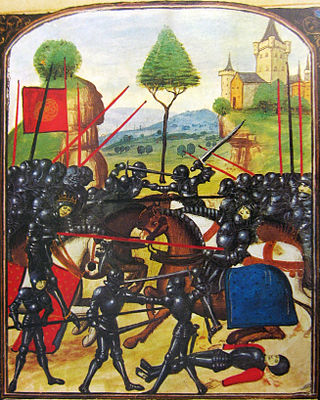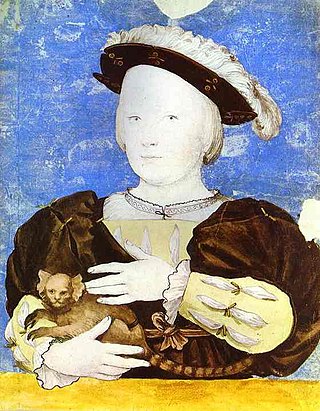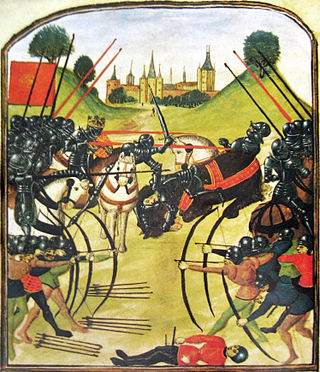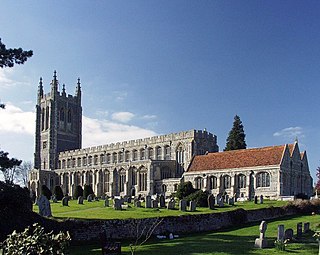
Edward III, also known as Edward of Windsor before his accession, was King of England from January 1327 until his death in 1377. He is noted for his military success and for restoring royal authority after the disastrous and unorthodox reign of his father, Edward II. Edward III transformed the Kingdom of England into one of the most formidable military powers in Europe. His fifty-year reign is one of the longest in English history, and saw vital developments in legislation and government, in particular the evolution of the English Parliament, as well as the ravages of the Black Death. He outlived his eldest son, Edward the Black Prince, and was succeeded by his grandson, Richard II.

Richard Neville, 16th Earl of Warwick, 6th Earl of Salisbury, known as Warwick the Kingmaker, was an English nobleman, administrator, landowner of the House of Neville fortune and military commander. The eldest son of Richard Neville, 5th Earl of Salisbury, he became Earl of Warwick through marriage, and was the wealthiest and most powerful English peer of his age, with political connections that went beyond the country's borders. One of the leaders in the Wars of the Roses, originally on the Yorkist side but later switching to the Lancastrian side, he was instrumental in the deposition of two kings, which led to his epithet of "Kingmaker".

The Battle of Barnet was a decisive engagement in the Wars of the Roses, a dynastic conflict of 15th-century England. The military action, along with the subsequent Battle of Tewkesbury, secured the throne for Edward IV.

The Battle of Towton took place on 29 March 1461 during the Wars of the Roses, near Towton in North Yorkshire, and "has the dubious distinction of being probably the largest and bloodiest battle on English soil". Fought for ten hours between an estimated 50,000 soldiers in a snowstorm on Palm Sunday, the Yorkist army achieved a decisive victory over their Lancastrian opponents. As a result, Edward IV deposed the Lancastrian Henry VI and secured the English throne.

Edmund the Martyr was king of East Anglia from about 855 until his death.
James Gairdner was a British historian. He specialised in 15th-century and early Tudor history, and among other tasks edited the Letters and Papers of the Reign of Henry VIII series.
Robert Fabyan was a London draper, Sheriff and Alderman, and author of Fabyan's Chronicle.

Baynard's Castle refers to buildings on two neighbouring sites in the City of London, between where Blackfriars station and St Paul's Cathedral now stand. The first was a Norman fortification constructed by Ralph Baynard, 1st feudal baron of Little Dunmow in Essex, and was demolished by King John in 1213. The second was a medieval palace built a short distance to the south-east and later extended, but mostly destroyed in the Great Fire of London in 1666. According to Sir Walter Besant, "There was no house in [London] more interesting than this".
John Hardyng was an English chronicler. He was born in Northern England.

The Act of Accord was an act of the Parliament of England. It was passed on 25 October 1460 during a period of intense political division and partisanship at the top of government. Three weeks earlier, Richard, Duke of York had entered the Council Chamber—in the presence of several lords—and laid his hand on the empty throne, claiming the crown of England. His grounds were that he and King Henry VI were both direct descendants of Edward III, but York possessed two claims, through both the male and female lines, and Henry's was through only one. Following discussions between Royal justices, York and Parliament, the House of Lords decided that Henry was to retain the crown for life, but York and his heirs were to succeed him. This automatically removed Henry's son, Edward, Prince of Wales, from the succession. Henry agreed to the compromise, which became the Act of Accord.

Henry Brandon, Earl of Lincoln was the youngest child and second son born to Charles Brandon, 1st Duke of Suffolk and Mary Tudor, Queen of France, who was a daughter of Henry VII, King of England. Thus Henry Brandon was nephew to King Henry VIII. His older sisters were Lady Frances Brandon and Lady Eleanor Brandon.
Montfichet's Tower was a Norman fortress on Ludgate Hill in London, between where St Paul's Cathedral and City Thameslink railway station now stand. First documented in the 1130s, it was probably built in the late 11th century. The defences were strengthened during the revolt of 1173–1174 against Henry II.

The Liber Eliensis is a 12th-century English chronicle and history, written in Latin. Composed in three books, it was written at Ely Abbey on the island of Ely in the fenlands of eastern Cambridgeshire. Ely Abbey became the cathedral of a newly formed bishopric in 1109. Traditionally the author of the anonymous work has been given as Richard or Thomas, two monks at Ely, one of whom, Richard, has been identified with an official of the monastery, but some historians hold that neither Richard nor Thomas was the author.

William Bonville, 1st Baron Bonville, was an English nobleman and an important, powerful landowner in south-west England during the Late Middle Ages. Bonville's father died before Bonville reached adulthood. As a result, he grew up in the household of his grandfather and namesake, who was a prominent member of the Devon gentry. Both Bonville's father and grandfather had been successful in politics and land acquisition, and when Bonville came of age, he gained control of a large estate. He augmented this further by a series of lawsuits against his stepfather, Richard Stucley. Bonville undertook royal service, which then meant fighting in France in the later years of the Hundred Years' War. In 1415, he joined the English invasion of France in the retinue of Thomas, Duke of Clarence, Henry V's brother, and fought in the Agincourt campaign. Throughout his life, Bonville was despatched on further operations in France, but increasingly events in the south-west of England took up more of his time and energy, as he became involved in a feud with his powerful neighbour Thomas Courtenay, Earl of Devon.
Siege of Thebes is a 4716-line poem written by John Lydgate between 1420 and 1422. Lydgate composed the Siege of Thebes directly following his composition of Troy Book - which was patronized by King Henry V - and directly preceding his production of The Fall of Princes - which Humphrey Duke of Gloucester patronized during King Henry VI's regency. The poem is particularly significant because it was written without an identifiable patron, and most probably without patron or commission whatsoever. Whatever the status of its patronage, the Siege of Thebes still managed to gain significant popularity, attested to by its 31 surviving manuscripts. The poem is, in large part, a response to Geoffrey Chaucer's The Canterbury Tales. Lydgate's poem borrows The Canterbury Tales' pilgrimage-based framing device and is written as an additional tale in the cycle. However, unlike Chaucer, Lydgate establishes himself as the narrator of the work, and recounts the siege of Thebes. Lydgate's Siege of Thebes follows and expands upon the Theban Cycle, but makes significant additions to the source materials.

The Wars of the Roses, known at the time and in following centuries as the Civil Wars, were a series of civil wars fought over control of the English throne from 1455 to 1487. The wars were fought between supporters of the House of Lancaster and House of York, two rival cadet branches of the royal House of Plantagenet. The conflict resulted in the end of Lancaster's male line in 1471, leaving the Tudor family to inherit their claim to the throne through the female line. Conflict was largely brought to an end upon the union of the two houses through marriage, creating the Tudor dynasty that would subsequently rule England.

The Church of the Holy Trinity is a Grade I listed parish church of the Church of England in Long Melford, Suffolk, England. It is one of 310 medieval English churches dedicated to the Holy Trinity.
The Brut Chronicle, also known as the Prose Brut, is the collective name of a number of medieval chronicles of the history of England. The original Prose Brut was written in Anglo-Norman; it was subsequently translated into Latin and English.
Gregory's Chronicle, the Chronicle of London, or MS Egerton 1995, is the name given to a fifteenth-century English chronicle. It takes its name from its supposed author, William Gregory, who started as a skinner in London and went on to become a London Alderman, Sheriff from 1436 to 1437, and eventually Mayor from 1450 to 1451. The name 'Gregory' for the manuscript is, however, merely a convenience, as its actual authorship is unknown. Indeed, since the chronicle spans the period 1189 to 1470, and William Gregory died in 1467, it is impossible for him to have composed it in its entirety. Other fifteenth-century authors have been proposed, ranging from a contemporary poet to an Ecclesiast, but since even the exact dates of its composition are also debated it has been impossible for historians to definitively attribute the authorship to any known individual.

The Loveday of 1458 was a ritualistic reconciliation between warring factions of the English nobility that took place at St Paul's Cathedral on 25 March 1458. Following the outbreak of the Wars of the Roses in 1455, it was the culmination of lengthy negotiations initiated by King Henry VI to resolve the lords' rivalries. English politics had become increasingly factional during his reign, and was exacerbated in 1453 when he became catatonic. This effectively left the government leaderless, and eventually the King's cousin, and at the time heir to the throne, Richard, Duke of York, was appointed Protector during the King's illness. Alongside York were his allies from the politically and militarily powerful Neville family, led by Richard, Earl of Salisbury, and his eldest son, Richard, Earl of Warwick. When the King returned to health a year later, the protectorship ended but partisanship within the government did not.














